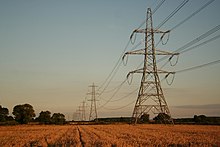The Central Electricity Generating Board (CEGB) was responsible for electricity generation, transmission and bulk sales in England and Wales from 1958 until privatisation of the electricity industry in the 1990s.
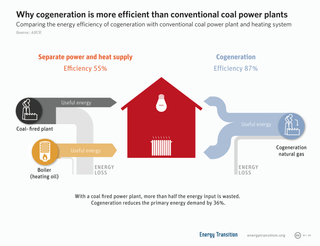
Cogeneration or combined heat and power (CHP) is the use of a heat engine or power station to generate electricity and useful heat at the same time.
British Energy was the UK's largest electricity generation company by volume, before being taken over by Électricité de France (EDF) in 2009. British Energy operated eight former UK state-owned nuclear power stations and one coal-fired power station.

Électricité de France S.A., commonly known as EDF, is a French multinational electric utility company owned by the French state. Headquartered in Paris, with €71.2 billion in revenues in 2016, EDF operates a diverse portfolio of at least 120 gigawatts of generation capacity in Europe, South America, North America, Asia, the Middle East, and Africa.
Centrica plc is a British multinational energy and services company with its headquarters in Windsor, Berkshire. Its principal activity is the supply of electricity and gas to consumers in the United Kingdom and Ireland.

The Office of Gas and Electricity Markets (Ofgem), supporting the Gas and Electricity Markets Authority (GEMA), is the government regulator for the electricity and downstream natural gas markets in Great Britain. It was formed by the merger of the Office of Electricity Regulation (OFFER) and Office of Gas Supply (Ofgas).
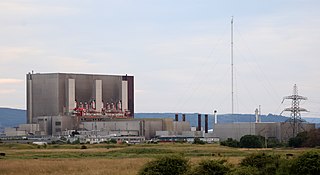
Hartlepool nuclear power station is a nuclear power station situated on the northern bank of the mouth of the River Tees, 2.5 mi south of Hartlepool in County Durham, North East England. The station has a net electrical output of 1,185 megawatts, which is 2% of Great Britain's peak electricity demand of 60 GW. Electricity is produced through the use of two advanced gas-cooled reactors (AGR). Hartlepool was only the third nuclear power station in the United Kingdom to use AGR technology. It was also the first nuclear power station to be built close to a major urban area.
This timeline outlines the key developments in the United Kingdom electricity industry from the start of electricity supplies in the 1870s to the present day. It identifies significant developments in technology for the generation, transmission and use of electricity; outlines developments in the structure of the industry including key organisations and facilities; and records the legislation and regulations that have governed the UK electricity industry.
Nuclear power in the United Kingdom generated 16.1% of the country's electricity in 2020. As of August 2022, the UK has 9 operational nuclear reactors at five locations, producing 5.9 GWe. It also has nuclear reprocessing plants at Sellafield and the Tails Management Facility (TMF) operated by Urenco in Capenhurst.
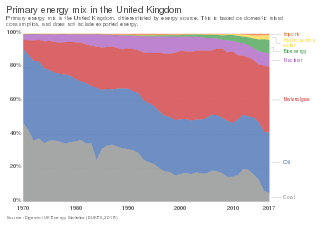
The energy policy of the United Kingdom refers to the United Kingdom's efforts towards reducing energy intensity, reducing energy poverty, and maintaining energy supply reliability. The United Kingdom has had success in this, though energy intensity remains high. There is an ambitious goal to reduce carbon dioxide emissions in future years, but it is unclear whether the programmes in place are sufficient to achieve this objective. Regarding energy self-sufficiency, UK policy does not address this issue, other than to concede historic energy security is currently ceasing to exist.
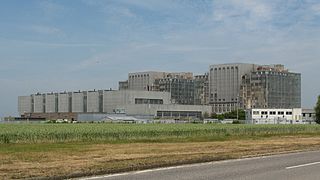
Bradwell nuclear power station is a Magnox-design nuclear power station that is undergoing decommissioning. It is located on the Dengie peninsula at the mouth of the River Blackwater, Essex. In 2019, it was the first nuclear power station in the UK to be placed into long-term decommissioned management. As of 2016, China General Nuclear Power Group is considering Bradwell for the site of a new nuclear power station, named Bradwell B.

Scottish Nuclear was formed as a precursor to the privatisation of the electricity supply industry in Scotland on 1 April 1990. A purpose-built headquarters was built in 1992 in the new town of East Kilbride.
Nuclear Electric was a nuclear power generation company in the United Kingdom. It was formed in 1990 as part of the privatisation process of the UK Electricity Supply Industry.

The Nuclear Energy Institute (NEI) is a nuclear industry trade association in the United States, based in Washington, D.C.

Renewable energy in Finland grew to 38.7% of total final energy consumption by year end 2014, achieving joint second position with Latvia in terms of renewable energy consumption by share amongst the EU-28 countries, behind its neighbour Sweden in first position on a 52.6% share. The 2014 share in Finland breaks down as renewable energy providing 52% of the heating and cooling sector, 31.4% of the electricity sector and 21.6% of the transport sector. By 2014, Finland had already exceeded its 2020 target for renewable energy use under the EU renewable energy directive as shown in the table of country targets.

Derwent Power Station is a mothballed 214MWe gas-fired power station on Holme Lane near Spondon in Derby, England. It is built on the site of the former Spondon Power Station
Blackburn Meadows power station is a biomass power station situated at Blackburn Meadows on the River Don, between Sheffield and Rotherham in South Yorkshire, England. Operated by E.ON UK, it was opened in 2014 and has an operating capacity of 30 megawatts.
The electricity sectors of the Republic of Ireland and Northern Ireland are integrated and supply 2.5 million customers from a combination of coal, peat, natural gas, wind and hydropower. In 2022, 34 TWh were generated. In 2018 natural gas produced 51.8%, while wind turbines generated 28.1%, coal 7%, and peat 6.8% of Ireland's average electricity demand. In 2020 wind turbines generated 36.3% of Ireland's electrical demand, one of the highest wind power proportions in the world. While the United Kingdom was one of the first countries in the world to deploy commercial nuclear power plants, the island of Ireland has never had a nuclear power plant built on either side of the Irish border. Nuclear power in Ireland was discussed in the 1960s and 1970s but ultimately never phased in, with legislation now in place explicitly forbidding its introduction.

The Nuclear Industry Association (NIA) is a subscription-based Trade association for the civil nuclear industry in the United Kingdom. It represents more than 260 companies across the nuclear supply chain. The diversity of NIA membership enables effective and constructive industry-wide interaction. It publishes the quarterly magazine, Industry Link, and it represents over 65,000 workers.
The Energy Networks Association (ENA) is the industry body funded by UK gas and electricity transmission and distribution licence holders. Its current Chief Executive is Lawrence Slade.
